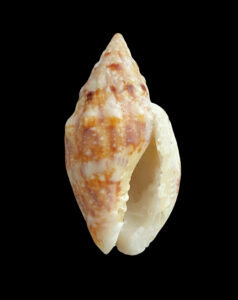 Cuming’s Lyria Shell, Enacta cumingii
Cuming’s Lyria Shell, Enacta cumingii
The Volutes of the Volutidae Family are gastropod mollusks that have large, glossy shells that vary considerably in appearance. They vary in outline from spindle to vase shaped, and the spire may be very low to moderately high. The whorls may be rounded or marked with knobs or spines. Their body whorl makes up the great majority of the shell, and the aperture is elongate. The inner lip of the aperture is marked with deep folds. These shells lack a siphon canal. The exterior of these shells are often beautifully decorated, usually in shades of white, brown, or orange. Most species in this family do not have an operculum. Living volutes have a large muscular foot and a long siphon, which assist them in hunting in soft substrates. The living animals are also often beautifully decorated. Volutes are large shells, reaching a maximum of 50 cm (19.5 inches) in height.
Volutes are usually found on, or burrowed under, clean sand substrates, though some are found in mud. They are predators that feed on mollusks and echinoderms. In turn, they are preyed upon by crabs, fish, and predatory mollusks. Volutes live intertidally, and to depths greater than 730 m (2,394 feet). Volutes are found worldwide, in tropical, temperate, and polar seas. There are about 200 species in the Volutidae Family, most of which are found in the indo-pacific. Two species are found in the coastal waters of western Mexico, and one is found in the Gulf of Mexico.